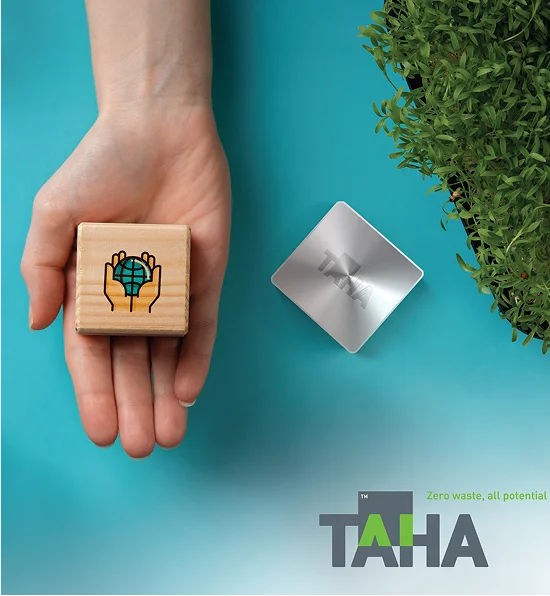DROSS MANAGEMENT
Our Process
Revolutionizing Aluminium Dross Recovery
At TAHA, we redefine aluminium dross management through an innovative two-stage recovery system. Designed to maximize efficiency and sustainability, our process ensures the highest possible recovery of valuable aluminium while significantly reducing environmental impact. Here’s how it works:
Mine
bauxite


Refine
alumina
Smelt and re-melt aluminium


Skim dross in
cast house
FULL ALUMINIUM CYCLE
TAHA OPERATIONS
Process hot dross


Process cold dross
Final
Products

Use depleted dross as feedstock
FULL ALUMINIUM CYCLE
TAHA OPERATIONS
Environmental Impact of Dross Management
TAHA’s innovative process sets a new standard in environmental responsibility by eliminating harmful practices associated with traditional dross processing.
Key Features of TAHA’s Environmentally Friendly Process
Elimination of Salt and Chemicals
TAHA’s process does not use salt or any other chemicals, unlike conventional rotary salt furnaces. This ensures that no toxic by-products are generated during aluminium recovery.
Avoidance of Hazardous Waste
Traditional methods produce "salt cake," a hazardous waste that is difficult to dispose of due to its environmental risks. Many regions, including Europe, have banned its disposal in landfills, requiring costly treatment facilities. TAHA eliminates this concern entirely.
Repurposing Residual
Oxides
The residual oxides from the process are not discarded. Instead, they are repurposed into valuable products such as Steel slag conditioners, Agricultural fertilisers, Heat-resistant outdoor tiles
Zero-Waste
Solution
By converting all residuals into feedstock for other industries, TAHA ensures a zero-waste process, aligning with global sustainability goals.
Comparison Between TAHA Method and Traditional Methods
TAHA's innovative approach to dross management outperforms traditional methods in several critical areas, setting a new benchmark for efficiency, cost-effectiveness, and environmental responsibility.
Criteria
Traditional Methods
TAHA’s Method
Energy Efficiency
High energy consumption due to rotary salt furnaces.
Low energy consumption with no additional energy inputs required.
Use of Chemicals
Requires salt and other chemicals, producing hazardous “salt cake.”
Eliminates the use of salt or chemicals, ensuring a clean process.
Environmental Impact
Produces “salt cake,” classified as hazardous waste, requiring costly disposal.
Zero-waste solution that repurposes residual oxides for various applications.
Aluminium Recovery
Limited recovery rates, leaving significant aluminium in the dross.
Recovers up to 90% of aluminium in the first stage and most of the remaining aluminium in the second stage.
Cost-Effectiveness
High operational costs due to energy use, chemicals, and waste treatment.
Cost-effective by reducing energy use, eliminating chemicals, and simplifying waste management.
Criteria
Energy Efficiency
Traditional Methods
High energy consumption due to rotary salt furnaces.
TAHA’s Method
Low energy consumption with no additional energy inputs required.
Criteria
Use of Chemicals
Traditional Methods
Requires salt and other chemicals, producing hazardous “salt cake.”
TAHA’s Method
Eliminates the use of salt or chemicals, ensuring a clean process.
Criteria
Environmental Impact
Traditional Methods
Produces “salt cake,” classified as hazardous waste, requiring costly disposal.
TAHA’s Method
Zero-waste solution that repurposes residual oxides for various applications.
Criteria
Aluminium Recovery
Traditional Methods
Limited recovery rates, leaving significant aluminium in the dross.
TAHA’s Method
Recovers up to 90% of aluminium in the first stage and most of the remaining aluminium in the second stage.
Criteria
Cost-Effectiveness
Traditional Methods
High operational costs due to energy use, chemicals, and waste treatment.
TAHA’s Method
Cost-effective by reducing energy use, eliminating chemicals, and simplifying waste management.
Residuals
The residual oxides from TAHA’s process are converted into feedstocks for various downstream applications. These include Steel Slag Conditioners, Agricultural Fertilisers, and Aluminium Trihydrate (ATH). This ensures no waste is left behind, making the process completely sustainable and beneficial for multiple industries.
Why Choose TAHA?
Key Advantages
Cost-Effectiveness
Reduces operational costs by eliminating the need for salt and additional energy, making the process more economical for clients.
Environmental Sustainability
Produces no hazardous waste and fully aligns with zero-waste principles, contributing to a more sustainable aluminium industry.
High Metal Recovery
Achieves recovery rates of up to 90% of aluminium in the first stage, with additional amounts recovered in the second stage, maximizing resource utilization.
Onsite Processing
Facilities are located near the client’s furnace, minimizing the need for reheating dross. This reduces energy consumption and enhances process efficiency.
Value Addition
Repurposes residual materials into useful products, such as steel slag conditioners and agricultural fertilisers, supporting various industries and promoting a circular economy.
